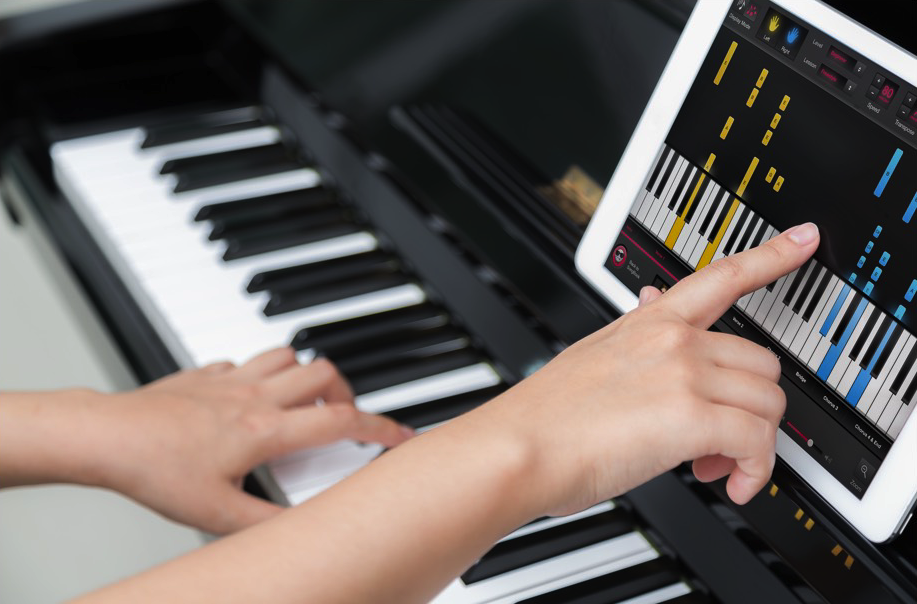Ah familial reunions, a concept so many of us dread. It is a time when you get to meet the farthest branches of your family tree, and get your cheeks pinched aplenty by your great uncle’s cousin’s sister. Believe it or not, not only humans have families. Yes even pianos must face that time of year when they must meet distant cousins and relatives from near and far. Today is a special day, as we, humans, get an exclusive peek into one such piano family reunion.
Let’s start from our familiar friend, the “you”, if you will, of familial reunions in the human world, the piano.
Meet the “you”: The Piano

The piano represents you in a family reunion. It is everything that is normal and in sync with societal norms, meaning that it has no bizarre features or behaviors. The same can’t be said of its family, however, who often draw unnecessary attention to themselves and embarrass the poor piano in public. Still, deep down inside, the piano loves them all and knows that the difference between them is not that great. After all, they are all family, and if it weren’t for them, the piano would not be as we know it today.
Meet the beer-bellied father: The Lautenwerck

The Lautenwerck is the good-natured father of the piano. It is of European descent and reached the peak of its “coolness” (something the piano does not believe its father ever was) back in 17th century. Like most of our fathers out there, the Lautenwerck has a healthy belly which results in a deep mellow tone when played. It was favored by Bach, and we assume that as the proud father of the piano, the Lautenwerck undoubtedly recommended the piano as a wonderful and special instrument to play. The result is of course Bach’s many piano masterpieces, and for that we are eternally grateful to the Lautenwerck!!
Meet the elegant mother: The Harmonium/Reed Organ

Meet the matriarch of the piano family, the mother hen if you will, the one who coos over the piano and ensures there is always harmony in the home, appropriately named the Harmonium. Living up to her namesake, the Harmonium’s volume and tonal range are limited, meaning that she produces a soft sound that is pleasant and harmonious to the ears. Still, she knows how to sound stern, and similar to human mothers who stamp their foot when you’re in trouble, the Harmonium too generates sound with foot-pump bellows.
Meet the well-groomed older sister: The Virginal

This is the virginal, the well-groomed older sister of the piano. Like many older sisters, she takes good care of herself, and is typically decorated with lots of colors and pretty designs. Call it makeup, if you will. The Virginal is a romantic at heart, and appropriately reached the peak of her popularity in the late Renaissance period (for comparison that’s around junior year of high school for humans). The Virginal is very much girly in her tendencies, she is elegant and dainty, and her higher notes appropriately produce a kind of fluttery flute-like sound.
Meet the annoying little brother: The Accordion

Most of us are familiar with the Accordion, and therefore know that much like many of our own little brothers, the accordion brings joy and energy to any place it ventures too, but also teeters quite frequently on the fine line between being entertaining to down-right annoying. The clown of the family, this younger sibling to the piano gained popularity in the early 20th century during the Vaudeville period, when circus antics were in full-blown fashion. And like all little brothers, the Accordion can be best handled only by the one who possesses the delicate gift to do so. Thus, when handled properly with the necessary skill and knowledge, this pint-sized goof becomes less of nuisance and more of a lovable jokester that can make beautiful music. 🙂
Meet the adorable baby sister: The Melodica

Meet the Melodica, the adorable outcome of crossing a piano with a harmonica. The younger sister of the piano, the Melodica was born in the 1950s, which makes her practically a baby in musical instrument years. Like human babies, Melodicas are small, light, portable and loud. Also, like most babies who put everything in their mouth, the Melodica is similarly played by being placed in other people’s mouths. When air is blown through the mouthpiece on the side of the Melodica, she makes sound that like human babies, brings joy to all who hear it.
Meet the black sheep of the family: The Tangent Piano

The black sheep of the family, we all have one. They are characterized as being different from the rest of us, and are known to be loud and provocative. In the piano’s family this role is taken by the Tangent Piano. What makes it a black sheep? Well, it is basically like the antithesis of the piano, which we all know is the picture perfect child of the piano family. For one thing, its keys are quite literally black and inverse to the piano’s. Also, unlike the piano which generally has a light and soft tone, the Tangent piano’s sound is much noticeably deeper in sound, darker if you will. Developing around the same time as the earliest of pianos in the early 18th century, it can almost be considered the piano’s “evil twin”, which is probably why is didn’t garner nearly as much popularity as the piano and is today extremely rare.
Meet the great-great grandfather: The Pipe Organ

The powerful being that we see here is none other than the Pipe Organ, the piano’s great-great grandfather. As with most grandpas, the Pipe Organ is never too far from a pipe. Most commonly used in churches or cathedrals, it produces its classic and dramatic sound by driving pressurized air (called wind, something another thing most grandpas have) through pipes selected via a keyboard. And no exception to the rule, the Pipe Organ has seen quite its fair share of history throughout its lifespan. First originating as just a little tyke in Greece in the 3rd century BC (!) over the years this powerful instrument has evolved and developed drastically into the complex instrument it is today, capable of producing different timbres, and a wide array of rich tonal colors and quality of sounds. Just like wine, time is on the Pipe Organ’s side!
Meet the majestic grandma: The Regal

Meet the Regal, the piano’s lovely dear ol’ grandma! Like many sweet elderly ladies, she is small and delicate. Belonging to the Aerophone (from the root “air”) family and the mother of the Harmonium, the Regal too works on the concepts of bellows, a trait that has also passed on to her boisterous grandson, the Accordion. The Regal is very dainty and elegant, and like her granddaughter the Virginal, she enjoys “makeup” and is typically decorated with gentle and soft designs.
Meet the cheek-pinching aunt: The Clavinet

We all know the phenomenon, cheek-pinching is a must at any family reunion, typically accompanied with exclamations such as “My, how you’ve grown!” Enter the Clavinet, the piano’s aunt who smothers everyone with endless love. With pincher-like feet sharp as razors, she eagerly always seeks the piano out in a familial reunion, wanting to turn it into her next pinching victim. But despite the smothering, the Clavinet is a fine instrument and has quite a cool side to her! She is an electro-mechanical keyboard instrument and back in the day partied along with the hippies of the 80s, when she rose to her prime.
Meet the eccentric uncle: The Caliope

Meet the cooky Caliope! He’s good hearted and a little bit quirky. Appropriately, he gained his fame in the place where it’s most acceptable to be loco, a place where loud whistles and steam run aplenty, on locomotive trains. Attention loving and boisterous, the Caliope, just like your own eccentric uncle, is typically very loud and can be heard from quite a distance away. Like its young nephew the Accordion, the Caliope can easily be found in carnivals, circuses and back-in-the-day travelling freak shows, bringing entertainment and a whole lot of fun wherever it goes.
Meet the cool cousin: The Keyboard

Meet the cool member of the piano family, the popular kid on the block that everyone has heard of and even you yourself are probably very familiar with, the keyboard. Often sleekly dressed in chrome or metallic black, the keyboard boasts a wide range of tricks it can do and is great at instrument impressions, have you tried the trumpet feature?? The piano looks up to its cool cousin and strives to be more like it, but we’re not so sure the piano should have such low self-esteem…
Meet the hipster cousin: The Keytar

Sibling to the keyboard, but living in a hipster world of its own, is the Keytar. The Keytar is in that stage of its life when its seeking its true identity and calling, and trying to decide if it’s more of a piano or a guitar at heart. The Keytar hangs out mostly with rock and punk bands and doesn’t care what anyone thinks of it. It’s time in the sun is just beginning too, and it was gifted its hipster nickname as recently as 2012. A wild child of the 21st century, keep an eye out for the Keytar, chances are you’ll start seeing them more often.
















Comment